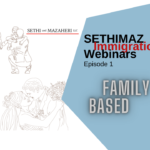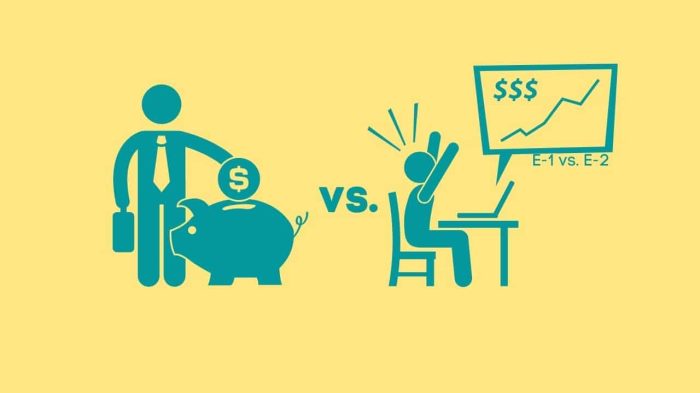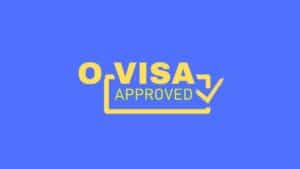Introduction
E-1 and E-2 visa forms part of the E visa category, which is granted to treaty traders and investors visiting the US under a treaty of commerce and navigation between the US and their home country. In this article, we will see the key differences between both visas.
What is an E-1 Visa?
An E-1 visa or the Nonimmigrant Treaty Trader visa is given to treaty traders conducting substantial trade in goods, including services and technology, mainly between the US and their country of origin. The term ‘substantial trade’ refers to the continuous flow of sizable international trade items involving numerous transactions over time. This type of visa is generally useful for business owners, senior managers, and other key company employees who manage and develop their business operations in the country. The international trade between the country of the origin and the US must form 50% of the total international trade of the company.
What is an E-2 Visa?
On the other hand, an E-2 visa or the Nonimmigrant Treaty Investor visa is given to treaty investors who invest a significant amount of money either in establishing a new business in the US or an existing business in the US. They have either invested in or are actively investing. It is essential to show that the investment must be significant and sufficient to operate a profitable business, which will lead to the creation of jobs for workers in the US. This visa is generally used for employees in executive or supervisory roles. An executive role is a position in which the person is authorized to make policy and possess the authority to influence the direction of the enterprise.
On the other hand, a supervisory role refers to one with overall supervisory authority over the enterprise. It is important to note here that with an E-2 visa comes the restriction over the capacity of the role allowed by the visa. The visa holder, in this case, cannot carry out employment that is not connected to the treaty enterprise subject to approval from the USCIS.
Eligibility for E-1 Classification:
To become eligible for an E-1 visa, the applicant has to satisfy the following eligibility criteria:
- The applicant must be a citizen of the country with whom the US has maintained a treaty of commerce and navigation;
- The applicant must be engaged in carrying on substantial trade in goods not limited to services and technology; and
- The applicant must engage in primary commerce between the US and the treaty country.
Eligibility for E-2 Classification:
To become eligible for an E-2 visa, the applicant has to satisfy the following eligibility criteria:
- The applicant must be a citizen of the country with whom the US has maintained a treaty of commerce and navigation;
- The applicant should have invested a substantial amount of capital in a bona fide enterprise in the US or is actively involved in the process of making such investment; and
- The intent of the applicant to enter the US must be about developing and directing the investment enterprise.
Process of Application for E-1 and E-2 visa
If you are filing from inside the US:
- You have to file Form I-129 (Petition for a Nonimmigrant Worker) and pay the filing fees. Make sure to include all the relevant documents and evidence along with your form. This form is used to request a change of status to E-1, E-2.
- If applicable, you may be required to for the biometrics.
- You will receive notice to appear for an interview.
- Finally, you will receive the notice of the final decision from the USCIS.
Note: A person cannot apply for a change of status to E-1 or E-2 visa holders through Form I-129 if they reside outside the US. Thus, the above process is only applicable to people living in the US.
If you are filing from outside the US:
Suppose you are filing from outside the country. In that case, you must file Form DS-160 (Nonimmigrant Visa Application), followed by a consular interview for the visa.
Visa Fees
The applicant needs to pay a sum of $460 for Form I-129. If you are filing the petition from outside the US, you need to file Form DS-160, costing $205. In case biometric services are required, then an amount of $85 is required to be paid.
Period of Stay:
An E-1 visa or an E-2 visa allows the holder to stay in the US for a maximum period of two years. However, the period of stay can be extended multiple times by requesting two-year extensions when the visa expires.
Dependents of an E-1 and E-2 visa holder:
Spouses and unmarried children under 21 may apply for a visa to accompany an E-1 or E-2 visa holder throughout their stay in the United States. Their stay in the country is dependent on the primary visa holder. The nationalities of the dependents could differ from the nationality of the investor or employer. The spouse of the primary visa holder may also apply for work authorization by filing Form I-765.
Conclusion:
The main difference between an E-1 visa and an E-2 visa lies in the person of interest. There is not much difference in application, filing fees, and the laws applicable to the dependents of both the visa holders. If you have further queries about E visas or your visa case, you can contact Sethi and Mazaheri law firm. Our experienced immigration attorneys will help you in resolving your visa queries and processing your case.








 by Prozco®
by Prozco®